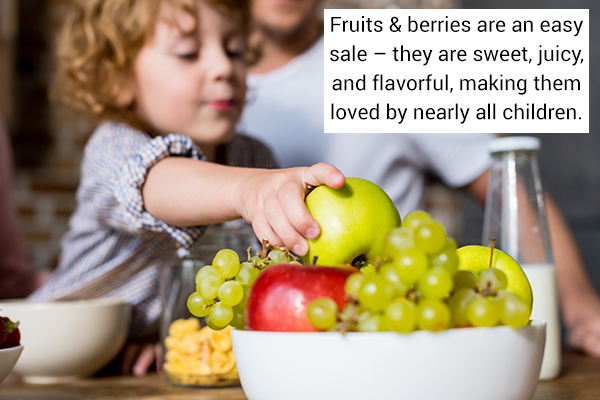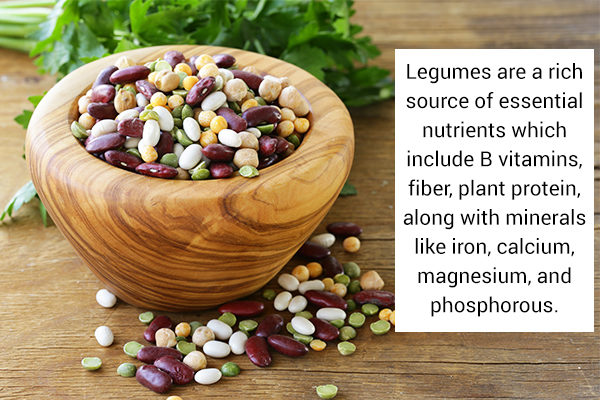In this article:
The health and well-being of growing children depend on many factors, one of them being nutrition. Although children need the same nutrients as adults do – vitamins, minerals, protein, carbohydrates, and fat – the amounts differ depending on the child’s age.

In the current environment, diets are dominated by convenient, quick, and highly palatable foods that are not always the best choices to address the needs of growing children.
Children do not have the ability yet to understand that some of the food choices they (or their caregivers) make are not in their best health interest, and they simply cannot provide food choices for themselves when they depend on their caregivers to do so. The more they eat foods high in fat, sugar, and sodium, the stronger will be their craving for them, as these foods are known to hijack the brain and hormones responsible for hunger and satiety. (1)
To prevent this vicious cycle from happening, it is important to keep a balance of healthy, fresh, whole-food choices – “anytime foods,” along with some of the less healthful options as “sometime foods.”
The following foods are great options for a child’s healthy growth and development.
1. Root Vegetables: Beetroot, Potatoes, Sweet Potatoes, Yams, Japanese Purple Potatoes, Carrots, Parsnips
Starchy root vegetables are rich sources of potassium, magnesium, fiber, beta-carotene, iron, and vitamins B and C, just to name a few.
Their different colors (orange, purple, yellow, white) speak for their content of potent antioxidants (anthocyanins, carotenoids, betalains) that are important in proper immune function and disease prevention. (2)
Most of these root vegetables have a slightly sweet taste (beetroot, potatoes, turnip), whereas others are truly sweet (sweet potato, carrot, yam), making them appealing and palatable, all the while offering good nutrition for growing children.
You can roast them, add them to stews, boil and mash them, and even make baked goodies with them.
2. Fruits and Berries: Apples, Pears, Oranges, Kiwi, Blueberries, Raspberries

Fruits and berries are an easy sale – they are sweet, juicy, and flavorful, making them loved by nearly all children. Fruits and berries are abundant in vitamins, minerals, and antioxidants, including vitamins A, B, and C, folate, potassium, magnesium, copper, and fiber. (3)(4)
They are easy to incorporate into recipes, such as toppings for oatmeal and yogurt, as ingredients in baked goods and smoothies, or as a snack by themselves.
3. Cruciferous Vegetables: Broccoli, Cauliflower, Cabbage, Kale, Brussels Sprouts, Arugula
Before you throw your hands up in the air, please read on! Cruciferous vegetables may be tougher to get kids to eat, but wait until you learn about all the important benefits they offer, and you’ll surely get creative with how to feed them to your children.
Cruciferous veggies are excellent sources of folate, fiber, phytonutrients, and vitamins A, C, and K. These are plant-sourced compounds that may help lower inflammation, strengthen the immune system, and reduce the risk of developing cancer. (5)
One particular compound in cruciferous vegetables that makes them cancer fighters is sulforaphane, which can potentially prevent DNA damage, activate defenses against pathogens and pollutants, and boost your liver detox enzymes. (6) Kids can crunch on them raw, dipped in their favorite dressing. These veggies can also be added to your regular fare.
For instance, steamed cauliflower mixes well in mashed potatoes or macaroni and cheese, fresh arugula can be topped on homemade pizza, and chopped broccoli can be added to pasta dishes.
4. Legumes: Beans, Peas, Lentils

Legumes are rich sources of various nutrients, including fiber, vitamin B, iron, calcium, magnesium, phosphorus, and plant protein.
The abundant fiber in these healthy foods helps alleviate occasional constipation, (7) which is prevalent among the young generation due to their less-than-optimal fiber intake.
Fiber also supports gut microbiome diversity. Friendly gut bacteria feed and proliferate on fiber, so keeping them fed keeps you healthy. Adequate consumption of foods rich in iron, such as beans, prevents and treats iron deficiency anemia, a condition that is sometimes observed in young children.
Beans and lentils are versatile and could be easily added to soups, chili, stews, casseroles, and salads. They can be eaten as side dishes or blended and used as a base for sauces and baked goods. (8)
5. Seeds: Sunflower, Pumpkin, Hemp, Chia, Flax
Seeds contain high concentrations of vitamin E, minerals, fiber, protein, and healthy fats. Small amounts go a long way as they are dense sources of minerals, such as magnesium, copper, manganese, phosphorus, selenium, zinc, iron, and potassium.
Seeds are great sources of monounsaturated fatty acids and some polyunsaturated fats, making them great choices for cardiovascular and neurological protective benefits. (9) Some seeds, including chia, hemp, and flax, contain essential fatty acids that are important for brain development.
Even though their conversion rate into functional EPA and DHA types of essential fats are low, they are still valuable sources that offer other health benefits. Ensure to crush or chop seeds in a food processor to avoid choking in young children before adding them to breakfast cereals, oats, applesauce, yogurt, or salad.
6. Whole Grains: Brown Rice, Quinoa, Buckwheat, Bulgur Wheat, Barley, Oats, Millet, Corn

Many packaged foods and commercially produced pastries contain lots of processed white flour, making it the most widely consumed grain in most people’s diets.
Processed flours are stripped of their beneficial nutritional values. Unprocessed bran is rich in fiber, trace minerals (iron, zinc, copper, and magnesium), and germ. The germ is a source of vitamins E and B, phytochemicals, and antioxidants.
Processed flours are usually enriched, which means vitamins and minerals are added back after processing. However, such a process disrupts grains’ natural integrity, making the nutrients less bioavailable.
Whole grains, on the other hand, have all the nutrients in their unadulterated form, making them better options for growing children. (10)
7. Homemade Baked Goodies and Such: Pancakes, Waffles, Brownies, Pies, Mug Cakes, Muffins, Cupcakes
You read that right – these are not all villains when it comes to healthy nutrition for children.
But I am not talking about store-bought or bakery-bought items, not even the “healthy” options from your local Whole Foods. I am talking about made-from-scratch foods where you control all the ingredients and their quality.
You can even get creative and experiment with different whole-grain flours, ground nuts and seeds, fresh fruits and even veggies, blended cooked beans, unsweetened chocolate, and avocado-based frostings.
Internet sources are endless when it comes to finding healthy dessert recipes. To my knowledge and in my experience with my own children and children I work with, no one can suppress kids’ sweet tooth, and the excitement you see on their cute little faces when given a decadent cupcake is just precious.
Why not tackle both: satisfy their need for the “good stuff’ and feed them healthy choices? A bonus, you become their favorite superhero – a true cherry on top! Not allowing children to eat their favorite sweets will create a sense of deprivation and may set the stage for an eating disorder later in life.
An important caveat here is to explain to children that not all seemingly same foods are created equal. Homemade items are usually healthier than store-bought. Teaching kids the importance of quality of foods will go a long way in helping them develop healthy eating habits and encouraging them to treat their body and health with respect.
Final Word
Many young children often show picky eating behaviors, making it challenging to ensure they are eating healthily. It is important to note that consistency is key when it comes to offering healthy choices.
Parents may get frustrated and impatient and quit putting certain foods in front of their children after a few unsuccessful attempts, but doing so will only make matters worse as children are being stripped of the choice.
Kids also pick up on the habitual patterns of their parents and caregivers. If parents frequently eat fruits and vegetables, they are being role models in cementing healthy eating habits for their children. Family-style dining, where everybody sits together at a table and passes around communal bowls of dishes, may help in instilling preferences for healthy foods.
- Was this article helpful?
- YES, THANKS!NOT REALLY


